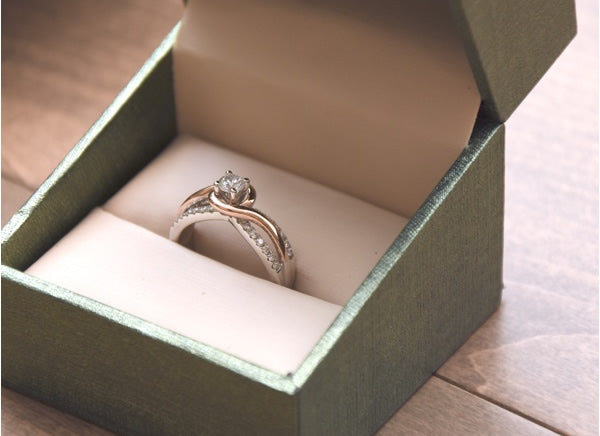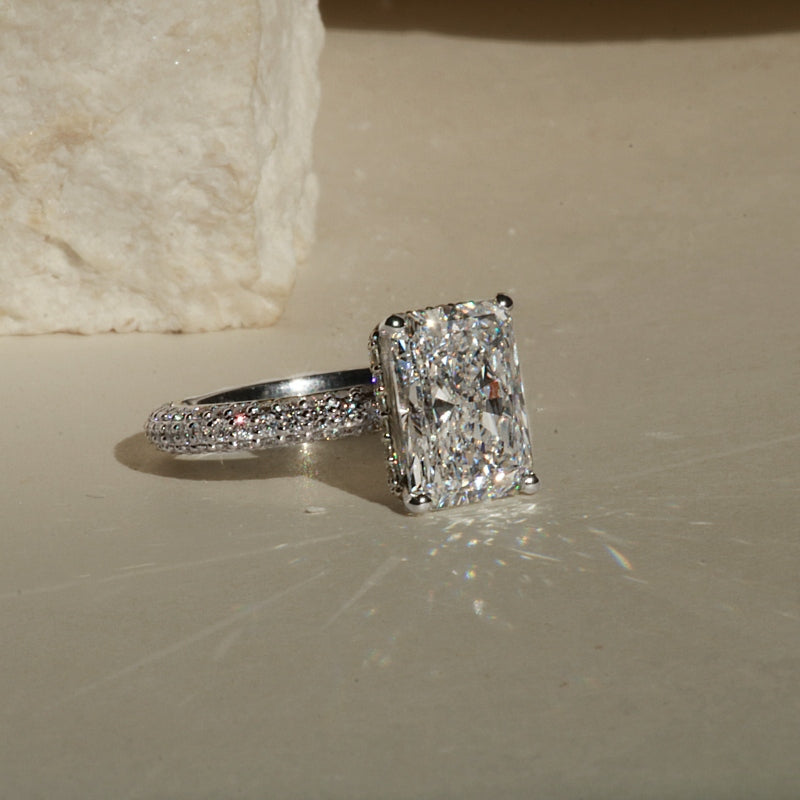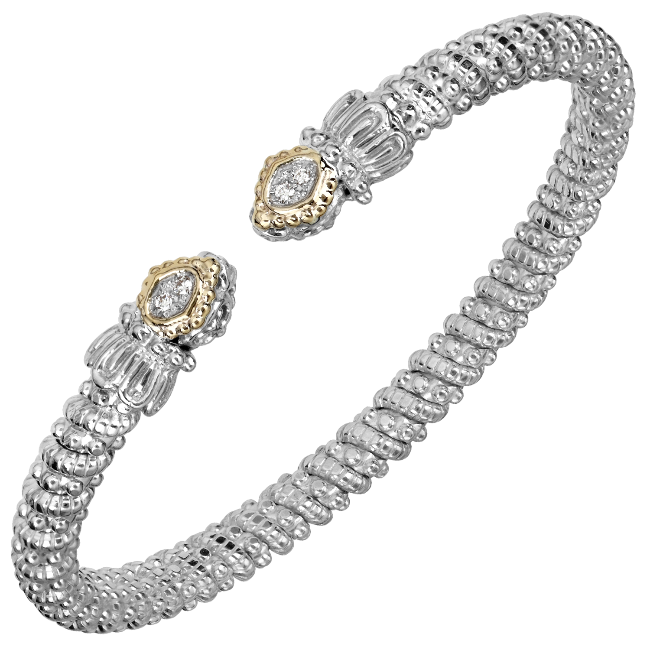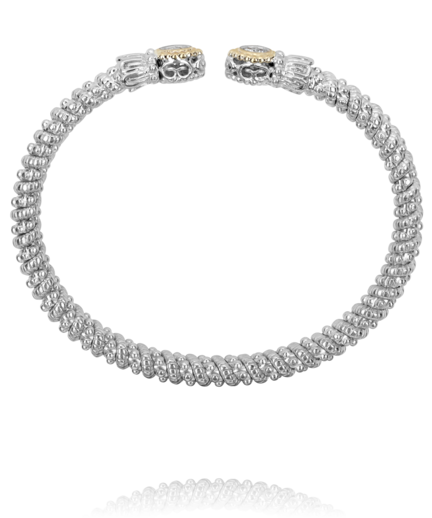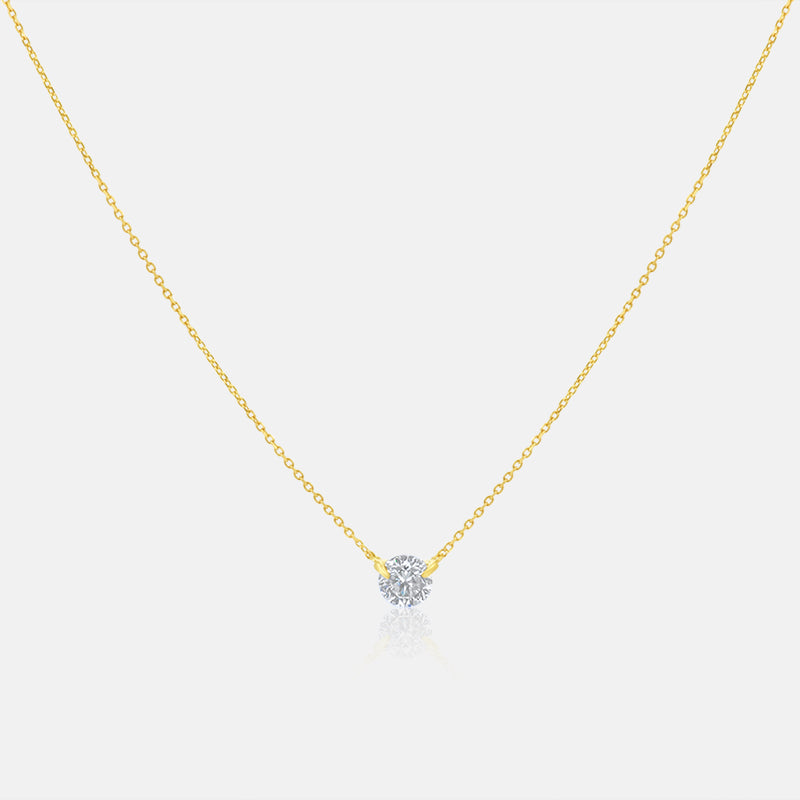 A diamond’s cut is not only about its shape, but how effectively the stone can return light back to the viewer’s eye. A well-cut diamond will appear very brilliant and fiery; while more poorly cut stones can appear dark and lifeless, regardless of color or clarity. Not only do well-cut diamonds appear more brilliant, they can also appear larger than other stones of the same carat weight. An ideal stone has both increased brilliance as well as increased diameter relative to more deeply cut diamonds. Each and every diamond will have its own unique set of properties and proportions. Diameter: Width of a polished stone, measured from edge to edge Table: Largest polished facet located on the top of the diamond Crown: The top part of a diamond extending from the table to the girdle Girdle: The very edge of the diamond where the crown and pavilion meet Pavilion: The bottom part of a diamond extending from the girdle down to the culet Depth: The total height of a diamond measured from the table to the culet Culet: The small or pointed facet at the very bottom of a polished stone Understanding Brilliance, Dispersion & Scintillation Well-proportioned diamonds exhibit three different properties: brilliance, dispersion and scintillation. As light strikes a diamond’s surface, it will either reflect off the table of a polished stone or enter into the diamond. The light that reflects is considered a diamond’s brilliance. Brilliance is the flash of white light one will see when looking at a stone. As light travels into a stone, some of rays are divided into flashes of color, which is called dispersion. Fire is the result of dispersion, which is the separation of white light into its spectral colors. As an observer moves a diamond back and forth, the flashes of color are called scintillation.
A diamond’s cut is not only about its shape, but how effectively the stone can return light back to the viewer’s eye. A well-cut diamond will appear very brilliant and fiery; while more poorly cut stones can appear dark and lifeless, regardless of color or clarity. Not only do well-cut diamonds appear more brilliant, they can also appear larger than other stones of the same carat weight. An ideal stone has both increased brilliance as well as increased diameter relative to more deeply cut diamonds. Each and every diamond will have its own unique set of properties and proportions. Diameter: Width of a polished stone, measured from edge to edge Table: Largest polished facet located on the top of the diamond Crown: The top part of a diamond extending from the table to the girdle Girdle: The very edge of the diamond where the crown and pavilion meet Pavilion: The bottom part of a diamond extending from the girdle down to the culet Depth: The total height of a diamond measured from the table to the culet Culet: The small or pointed facet at the very bottom of a polished stone Understanding Brilliance, Dispersion & Scintillation Well-proportioned diamonds exhibit three different properties: brilliance, dispersion and scintillation. As light strikes a diamond’s surface, it will either reflect off the table of a polished stone or enter into the diamond. The light that reflects is considered a diamond’s brilliance. Brilliance is the flash of white light one will see when looking at a stone. As light travels into a stone, some of rays are divided into flashes of color, which is called dispersion. Fire is the result of dispersion, which is the separation of white light into its spectral colors. As an observer moves a diamond back and forth, the flashes of color are called scintillation.
 A diamond’s cut is not only about its shape, but how effectively the stone can return light back to the viewer’s eye. A well-cut diamond will appear very brilliant and fiery; while more poorly cut stones can appear dark and lifeless, regardless of color or clarity. Not only do well-cut diamonds appear more brilliant, they can also appear larger than other stones of the same carat weight. An ideal stone has both increased brilliance as well as increased diameter relative to more deeply cut diamonds. Each and every diamond will have its own unique set of properties and proportions. Diameter: Width of a polished stone, measured from edge to edge Table: Largest polished facet located on the top of the diamond Crown: The top part of a diamond extending from the table to the girdle Girdle: The very edge of the diamond where the crown and pavilion meet Pavilion: The bottom part of a diamond extending from the girdle down to the culet Depth: The total height of a diamond measured from the table to the culet Culet: The small or pointed facet at the very bottom of a polished stone Understanding Brilliance, Dispersion & Scintillation Well-proportioned diamonds exhibit three different properties: brilliance, dispersion and scintillation. As light strikes a diamond’s surface, it will either reflect off the table of a polished stone or enter into the diamond. The light that reflects is considered a diamond’s brilliance. Brilliance is the flash of white light one will see when looking at a stone. As light travels into a stone, some of rays are divided into flashes of color, which is called dispersion. Fire is the result of dispersion, which is the separation of white light into its spectral colors. As an observer moves a diamond back and forth, the flashes of color are called scintillation.
A diamond’s cut is not only about its shape, but how effectively the stone can return light back to the viewer’s eye. A well-cut diamond will appear very brilliant and fiery; while more poorly cut stones can appear dark and lifeless, regardless of color or clarity. Not only do well-cut diamonds appear more brilliant, they can also appear larger than other stones of the same carat weight. An ideal stone has both increased brilliance as well as increased diameter relative to more deeply cut diamonds. Each and every diamond will have its own unique set of properties and proportions. Diameter: Width of a polished stone, measured from edge to edge Table: Largest polished facet located on the top of the diamond Crown: The top part of a diamond extending from the table to the girdle Girdle: The very edge of the diamond where the crown and pavilion meet Pavilion: The bottom part of a diamond extending from the girdle down to the culet Depth: The total height of a diamond measured from the table to the culet Culet: The small or pointed facet at the very bottom of a polished stone Understanding Brilliance, Dispersion & Scintillation Well-proportioned diamonds exhibit three different properties: brilliance, dispersion and scintillation. As light strikes a diamond’s surface, it will either reflect off the table of a polished stone or enter into the diamond. The light that reflects is considered a diamond’s brilliance. Brilliance is the flash of white light one will see when looking at a stone. As light travels into a stone, some of rays are divided into flashes of color, which is called dispersion. Fire is the result of dispersion, which is the separation of white light into its spectral colors. As an observer moves a diamond back and forth, the flashes of color are called scintillation.



